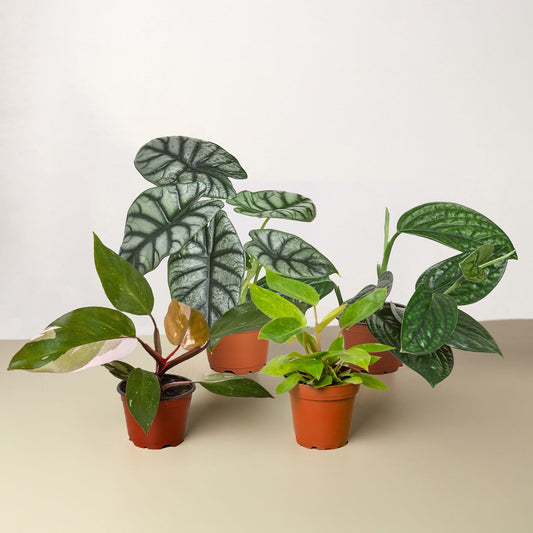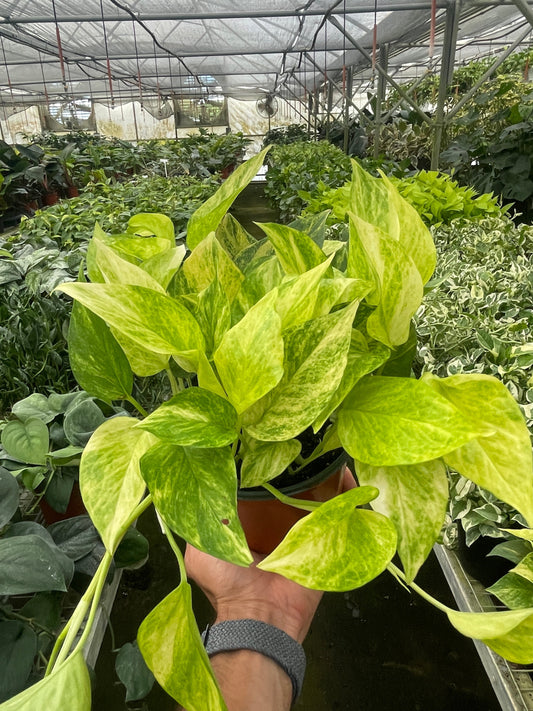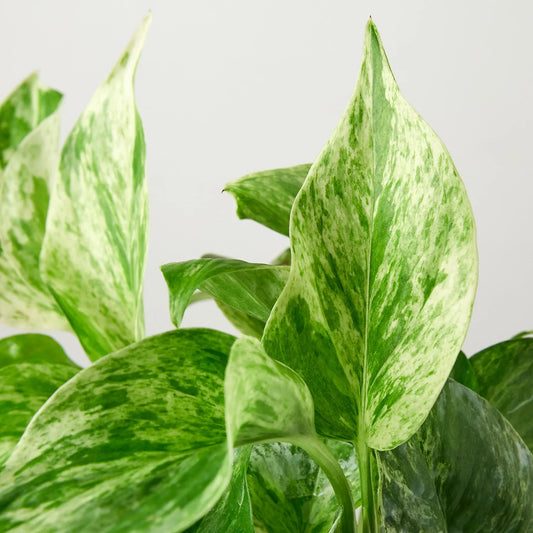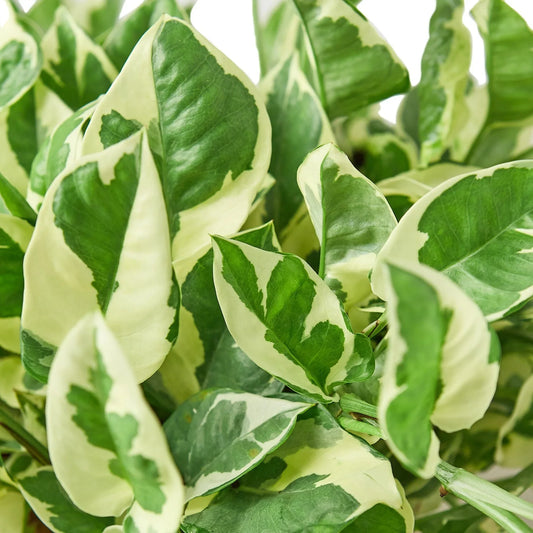How To Grow A Ficus Alii WITHOUT A Moss Pole
Cafe Planta Team
Growing a Ficus Alii without a moss pole might sound a little tricky at first, but it's completely doable! These elegant trees with their long, narrow leaves make a stunning addition to any home, and you don’t need a moss pole to enjoy their beauty. If you've been wondering how to get started, you're in the right place.
In this blog, we'll explore everything from selecting the right pot and soil to understanding the best lighting and watering practices for your Ficus Alii. We’ll also touch on common pest issues and how to handle them, along with some design tips to incorporate your plant into your living space beautifully. Ready to become a proud Ficus Alii plant parent? Let’s get growing!
Choosing the Right Pot and Soil
First things first, let’s talk about pots. Choosing the right pot for your Ficus Alii is like picking the perfect pair of shoes; it needs to be both functional and stylish. You’ll want a pot with good drainage holes to prevent water from sitting at the bottom, which can lead to root rot. Trust me, no one wants to deal with root rot—it’s the plant equivalent of soggy socks.
When it comes to size, bigger isn’t always better. A pot that’s too large can hold too much moisture, causing the roots to drown. Start with a pot that’s just a couple of inches larger than the root ball of your plant. As your ficus grows, you can gradually move it into larger pots.
Now, onto soil. Ficus Alii isn’t too picky, but it does appreciate well-draining soil. You can either buy a high-quality potting mix or whip up your own by mixing regular potting soil with some perlite or sand to improve drainage. Remember, happy roots make for a happy plant!
Setting the Stage with the Right Lighting
Let’s face it, we all need a little sunshine in our lives, and your Ficus Alii is no exception. However, while these plants love bright light, they don’t want to be scorched by direct sun. Think of them as sunbathers who prefer lounging under an umbrella rather than roasting on a towel.
Place your Ficus Alii near a window where it can soak up plenty of indirect sunlight. East or west-facing windows are usually ideal. If your plant starts to look a bit leggy or the leaves begin to lose their color, it might be craving more light. On the flip side, if the leaves are turning brown at the edges, it might be getting too much sun.
Don’t have the perfect spot? No worries! You can always supplement with a grow light to give your Ficus the light it craves. Just make sure the light isn’t too harsh—think gentle sunbeam rather than interrogation lamp.
Mastering the Art of Watering
Watering is where many plant parents stumble, but it doesn’t have to be a guessing game. The key to watering your Ficus Alii is balance: neither too much nor too little will do. Think of it like Goldilocks’ porridge—just right is the goal.
Stick your finger about an inch into the soil. If it feels dry, it’s time to water. If it’s still moist, give it a few more days. When you do water, make sure to do so thoroughly, allowing excess water to drain out of the pot. This ensures that the roots are getting a good drink without sitting in water.
During the growing season (spring and summer), your Ficus Alii will likely need more water. In the cooler months, you can scale back as the plant’s growth slows. A little tip: overwatering is a more common problem than underwatering, so when in doubt, err on the side of dry.
Feeding Your Ficus Alii
Think of fertilizer as your plant’s multivitamin. While your Ficus Alii can survive without it, a little boost now and then will keep it looking its best. During the growing season, you can feed it with a balanced liquid fertilizer every month or so.
Don’t go overboard, though. Too much fertilizer can do more harm than good, leading to burnt roots and sad-looking leaves. Always follow the instructions on your fertilizer of choice. If you're using a granular fertilizer, make sure to water it in well so the nutrients reach the roots.
In the fall and winter, your ficus will naturally slow down its growth, and you can take a break from feeding it. Think of this as its hibernation period—a time to rest and recharge.
Handling Common Pests
Just like us, plants sometimes have to deal with uninvited guests. Ficus Alii can fall prey to pests like spider mites, mealybugs, and scale. Fortunately, there are ways to handle these pesky critters without losing your mind.
- Spider Mites: These tiny bugs can be hard to see, but if you notice fine webs on your plant, it’s time to act. A good rinse with water can help. For a more thorough treatment, use insecticidal soap or neem oil.
- Mealybugs: These look like little cotton balls and can be wiped away with a damp cloth. A cotton swab dipped in alcohol can also do the trick.
- Scale: These pests appear as small, brown bumps on the stems and leaves. You can scrape them off gently with your fingernail or a soft brush.
Regularly inspecting your plant will help you catch any problems early before they become bigger issues. And remember, a healthy plant is less likely to be bothered by pests, so keeping your Ficus in good shape is your best defense.
Pruning for Health and Style
Pruning might sound scary, but it’s actually a great way to keep your Ficus Alii looking sharp. Regular pruning encourages bushier growth and helps maintain the shape of your plant. Plus, it’s a little like giving your plant a haircut—it’s all about keeping things tidy and fresh.
Use clean, sharp scissors or pruning shears to remove any dead, damaged, or crossed branches. You can also trim back the tips of branches to encourage a fuller look. Just be careful not to go overboard; you want to maintain your plant’s natural shape.
If your plant is getting too tall for its space, you can also prune the top to control its height. Don’t worry—your Ficus will thank you for it with new, healthy growth.
Incorporating Ficus Alii into Your Home Design
Now that your Ficus Alii is thriving, it's time to think about its role in your home decor. These plants make a bold statement, with their graceful, arching branches and lush foliage. So how can you best showcase this beauty?
Consider the following design tips:
- Living Room: A Ficus Alii can add height and drama to a corner, filling up vertical space with its elegant structure.
- Office: Placing a Ficus Alii near your desk can bring a touch of nature into your workspace, promoting calm and focus.
- Entryway: Welcome guests with a stunning Ficus Alii by the door. It’s an inviting way to greet visitors and set the tone for your home.
Remember, the pot you choose can also be part of the decor. Whether you opt for a sleek, minimalist design or something more colorful and ornate, the pot can complement your overall aesthetic. And if you’re short on floor space, consider using a plant stand to elevate your Ficus and add dimension to the room.
Repotting Your Ficus Alii
As your Ficus Alii grows, it’ll eventually need a new home. Repotting is an important step in ensuring your plant has room to spread its roots and continue thriving. But how do you know when it’s time to repot?
Look for signs like roots growing out of the drainage holes or the soil drying out more quickly than usual. These are telltale signs your plant is becoming root-bound and needs more space.
When repotting, gently remove the plant from its current pot, taking care not to damage the roots. Trim any dead or overly long roots, and place the plant in a new pot with fresh soil. Water it thoroughly to help it settle in, and voila—your Ficus Alii is ready to grow!
Dealing with Leaf Drop
Leaf drop is a common concern among plant parents, and it can be a bit disheartening. But don’t panic! While some leaf drop is normal, especially as your plant adjusts to its new environment, excessive leaf drop can indicate stress.
Common causes include:
- Overwatering/Underwatering: Check your watering routine to ensure you’re not over or underdoing it.
- Light Changes: Moving your plant to a new spot with different light conditions can cause stress. Try to keep lighting consistent.
- Temperature Fluctuations: Drafts, heating vents, or sudden temperature changes can all lead to leaf drop. Keep your plant in a stable environment.
By addressing these issues and giving your Ficus Alii a little time to adjust, you’ll likely see new growth start to emerge.
Understanding Your Ficus Alii’s Growth Pattern
Unlike some other houseplants, the Ficus Alii grows vertically, reaching toward the light. Without a moss pole, it can still develop a strong trunk and branches, making it a robust addition to your plant collection.
As it grows, you might notice it leaning slightly toward the light source. This is perfectly normal. You can rotate the pot every few weeks to encourage even growth and prevent it from becoming lopsided.
While the Ficus Alii doesn’t require a moss pole, providing a stake or support stick can help guide its growth and keep it stable, especially as it reaches taller heights. This can be particularly helpful if your plant is growing in a breezy area or if it’s getting top-heavy.
Final Thoughts
Growing a Ficus Alii without a moss pole is not only possible but can be a rewarding experience. With the right pot, soil, lighting, and care, your plant will thrive and bring a touch of nature's beauty into your home.
At Cafe Planta, we love helping plant people on their journey. Whether you need a new plant, accessories, or just some advice, feel free to reach out to us via email or Instagram. We believe in the power of plants to bring joy and connection, and we're here to support you in creating a thriving plant collection at home.



















